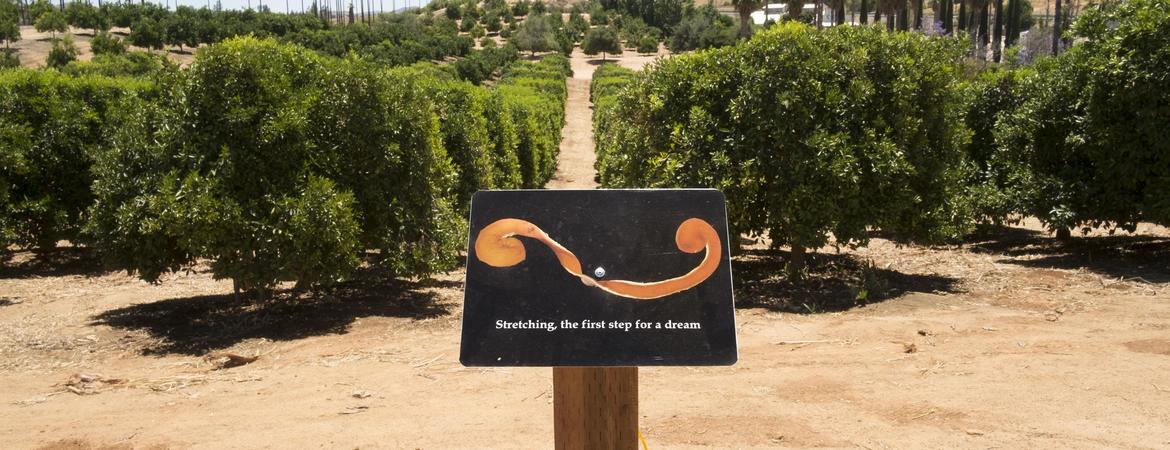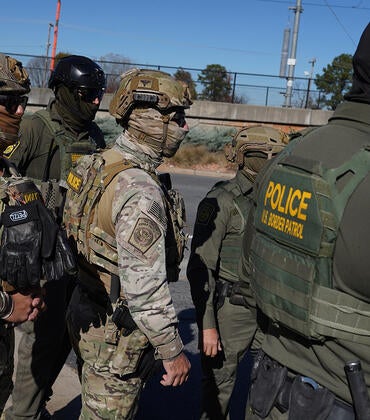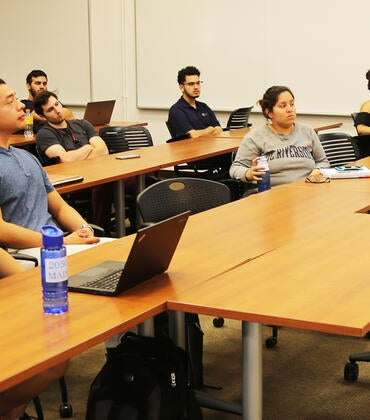
Step inside the Visitor Center and Museum at Riverside’s California Citrus State Historic Park and one of the first images you’ll see is a photograph of a smiling Manuel Venegas.
A Riverside native, Venegas is also a former “rata,” one of the many child laborers who spent his boyhood working in the kinds of sprawling citrus groves the state park is known for. At just 5 years old, he’d scurry among the trees, collecting low-hanging and fallen fruit to supplement the larger haul his father and older brother had already picked. Later, he’d go on to join the Marine Corps.
Venegas’ story is a single spoke in the wheel of diverse narratives on view in the state park’s latest exhibit, “Finding Ourselves in the Groves: Stories and Storytellers of Citrus in Inland Southern California.” The exhibit, which frames the Visitor Center’s entryway, is a product of the Relevancy and History Project, a partnership between the Public History program at the University of California, Riverside and California State Parks.
Focused on themes of migration and immigration, the project is being piloted at California Citrus State Historic Park. Its primary goal is to seek out new ways to tell the stories of the various groups who ushered in what some refer to as California’s second Gold Rush: an explosive citrus boom that began in the 1870s and altered the region’s development.
“Most of all, the exhibit features different groups of people as a way to also understand how the contemporary landscape has been shaped historically by industry, ideas about race and citizenship, and public policies about immigration and segregation,” said Catherine Gudis, director of UCR’s Public History program, who has led the project since 2016. “Through projects like this one, we’re trying to fill in some of the gaps in the literature about Riverside’s history.”
A Collaborative Approach
Filling in those gaps has involved a variety of approaches and initiatives, from researching regional library archives to organizing “community collection days” that give locals the opportunity to have old photos digitized in exchange for sharing their recollections of life in the groves.
The project’s public humanities fellows, UCR graduate students Megan Suster and Steven Moreno-Terrill, have collaborated with Gudis to document oral histories, shape the exhibit’s tone, and creatively rally the community in support of the park.
As a result, the park now counts a variety of partnering groups among its advocates.
So far, they include 1900 in Black, the Japanese American Citizens League, the Save Our Chinatown Committee, the Riverside African American Historical Society, the Riverside County Mexican American Historical Society, Sherman Museum, Malki Museum, and Tesoros de Casa Blanca.
With those groups and additional student participants, the project team has organized festivals, talks at the park, and a speakers’ bureau that presents new research findings at regional locations. They’ve also worked with artists such as UCR Department of Art alumna Kate Alexandrite, whose “Sour Puss” series of candid portraits of visitors is one of the focal points of the exhibit.
Other artists commissioned by the Relevancy and History Project include photographer Thomas McGovern and poet Juan Delgado. The pair’s interpretive art installations and photographs of contemporary citrus pickers and packers are incorporated in both the Visitor Center exhibit and among the groves themselves, where they serve as trail markers.
Faces in the Groves
“From a visitor’s perspective, for a long time the park didn’t really have people in it,” Suster said. “We wanted to bring more personal and local stories into the park so that more of the people who visit can see themselves here.”
“It really comes down to the stories of labor, and the ways that communities were forged,” Gudis added. “Who are the people behind this landscape?”
Manuel Venegas poses beside a portion of the exhibit dedicated to his history as a citrus laborer.
Thematically, the exhibit’s sections trace indigenous stories of migration and tackle the immigration of different groups to Inland Southern California following Eliza Tibbets’ planting of the region’s first viable navel orange trees. Colorful panels feature images and histories of Chinese, Italian, Japanese, and Korean laborers. One section dedicated to the experiences of African American settlers in the region chronicles their expertise as grove owners, arborists, and investors.
Other portions tell the stories of young “ratas” and Native American youth from nearby Sherman Institute, a residential boarding school that sent its students to work in citrus fields and factories as part of a school-sponsored “outing program.”
“Almost everyone we met with — no matter their race — said they had to pick when they were kids,” Gudis said. “It quickly became obvious that citrus runs deep here.”
Some storied figures, like Simona Valero, born in 1922 in Riverside’s Casa Blanca neighborhood, narrated citrus history through their own family trees. Valero’s relatives came to the area to pick, then ran a boarding house for laborers called “braceros,” one of whom she eventually married.
A key component of the binational Mexican Farm Labor Agreement forged by the U.S. and Mexico in 1942, the Bracero Program was launched at the height of World War II. Initially an effort to replenish the country’s dwindling supply of laborers, the program allowed Mexican citizens to enter the U.S. as guest workers until 1964.
“The braceros’ stories are bittersweet,” Gudis said, noting that for many braceros, labor regulations were scant and housing options were unconventional (think camps and former prison barracks). “It’s stories like theirs that helped inform what we wanted to say about the park and its history. Many of the existing depictions of our region’s citrus heritage are tired, and some are downright offensive — they represent a myopic view that often doesn’t consider on whose backs the area’s reputation was built.”
Suster said examining the patterns of migration and immigration surrounding the citrus industry has broadened her understanding of Inland Southern California’s history.
“The traditional storyline that people in this region tend to tell about the citrus industry is based on waves of immigration, but the reality is a little more complicated than that,” she said. “Things weren’t as segmented or segregated as people typically think — people lived next to each other and with each other, they went to school together, they were friends. Those kinds of connections have gotten lost over time.”
What’s Ahead
Suster and Moreno-Terrill were recently hired as full-time interpreters by the park. And with the state-supported grant that funds the project extended through March 2019, they can continue their work with Gudis and a team of UCR researchers.
Part of that work will involve staging more community collection days at places like Riverside’s Arlington, Casa Blanca, Downtown, and Eastside libraries. The oral-history technique has inspired interpreters at other California State Parks to document the stories of individuals with ties to their own sites.
“Other interpreters have realized, ‘Hey, I can do that — and I want to do that,’” Suster said, adding that teaching staffers at sister parks to mimic the methods employed in Riverside will help move the Relevancy and History Project beyond the pilot stage.
“One of the best parts of this project is that we’ve had the opportunity to sit with various community elders and record their stories,” Moreno-Terrill said. “It’s been such an honor to see people light up — and to realize what it means for them to have their stories represented and preserved.”
The California Citrus State Historic Park is located at 9400 Dufferin Ave. in Riverside.



